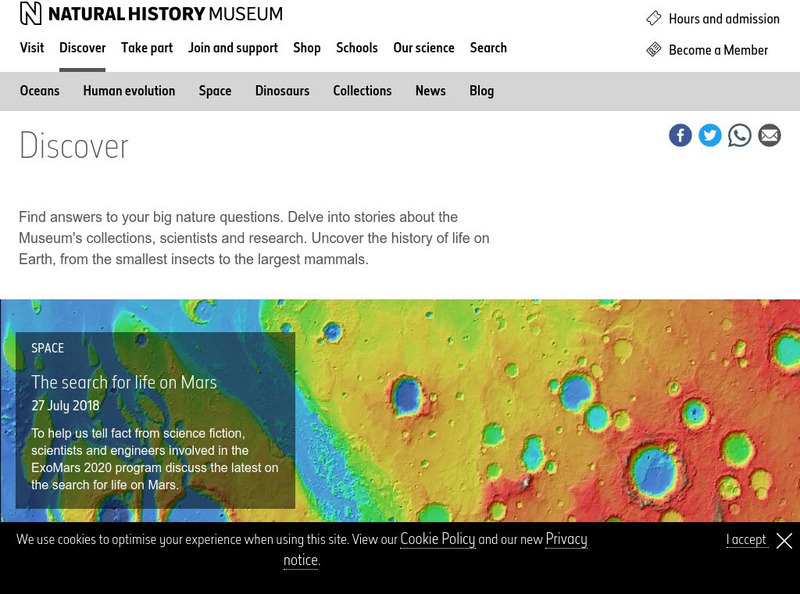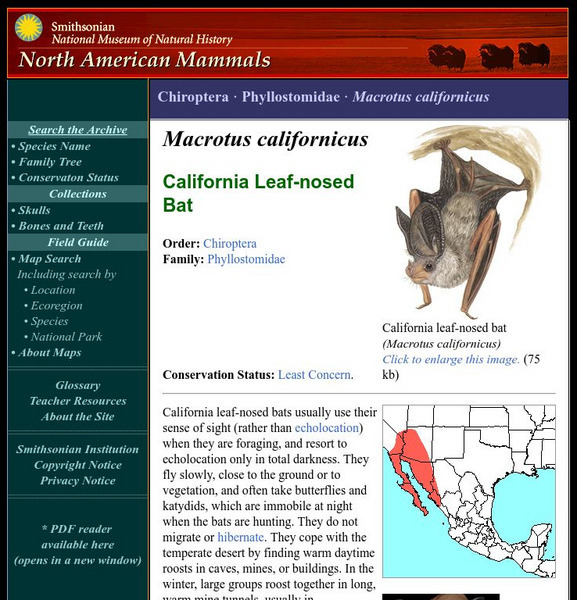Hi, what do you want to do?
Curated OER
Nocturnal Animals
In this animal worksheet, learners complete a cloze activity about nocturnal animals by filling in the blanks in 2 paragraphs using 9 words from a word bank. They color and cut out 13 small pictures of nocturnal animals and paste them in...
Curated OER
Nocturnal Animals Cloze Activity
In this science cloze activity, 3rd graders fill in the 9 blanks in a selection about nocturnal animals. They use the words from a word bank at the bottom of the page to complete the paragraph. They cut out pictures of nocturnal animals...
Curated OER
Connect the Dots
In this connect the dot worksheet, students connect the dots to reveal a flying mammal that uses radar-like echolocation to find its way around in the dark.
Curated OER
Mammals Crossword
In this mammals worksheet, students complete a crossword puzzle with 37 questions about characteristics, behavior and types of mammals.
Curated OER
Echo Location
Students participate in a role-playing activity that demonstrates how whales use sound as an adaptation to their environment.
Curated OER
Come to Mommy
Fourth graders participate in a simple experiment to illustrate the concept of mother bats identifying their young. They sniff stickers in order to imitate the behavior of mother bats in the wild.
Curated OER
What Shape Is It?
Students predict the shape of an unknown object by bouncing a ball on it. For this physics lesson, students relate this activity to how dolphins use echo-location to navigate. They analyze their lab result and discuss findings.
Curated OER
Night Hike
Students explore Upham Woods at night and investigate about the special adaptations of nocturnal animals. They identify three nocturnal animals and how they are adapted to the night. Students explain what night vision is and how it works.
Curated OER
Nocturnal Animals Lesson Plans
Creatures of the night aren't scary, but elicit much wonder and delight. Check out these nocturnal animal lesson plans for teaching ideas.
TeachEngineering
Teach Engineering: Biomimicry: Echolocation in Robotics
Students use ultrasonic sensors and LEGO MINDSTORMS NXT robots to emulate how bats use echolocation to detect obstacles. They measure the robot's reaction times as it senses objects at two distances and with different sensor threshold...
Science Buddies
Science Buddies: Bat Detector: Listen to the Secret Sounds of Bats
Sometimes bats can "whoosh" right by you, and not be seen. In this science fair project, you will be able to detect flying bats by listening in on the ultrasonic signals they produce to locate objects in their environment. The bat...
Scientific American
Scientific American: A Field Guide to Bats : In Depth Reports
Uncover the evolutionary past of the mysterious bats. Find out about their amazing ability to use sonar, the threat of rabies they carry, and conservation efforts to save the species.
Natural History Museum
Natural History Museum: The Secret Life of Bats: Bat Senses
Part of an online exhibit on bats, this section focuses on bat senses: sight, olfaction (smell), echolocation, and hearing.
Unite for Literacy
Unite for Literacy: Mystic Aquarium: Bats Dare to Be Different
Read about bats' characteristics, habitat, diet, behavior, and their unique hearing ability called echolocation. You'll also learn why they are important to humans, the threats they face, and what you can do to help them. Includes audio...
Library of Congress
Loc: Everyday Mysteries: Why Do Bats Live in Caves?
Ever wonder why bats live in caves? Or why bats don't fly into objects at night? This article describe why bats thrive in the protected shelter a cave provides. It also explains how bats use echolocation to locate food and avoid obstacles.
Other
Contra Costa County Office of Education: Bats: Why Should You Care?
At this site, provided by the Contra Costa County Office of Education, you can get the facts on bats and their environment.
Read Works
Read Works: Bat News
[Free Registration/Login Required] This nonfiction passage describes the job of a chiroptologist, a bat scientist. This passage reinforces essential reading comprehension skills. Opportunities for vocabulary acquisition are also...
PBS
Pbs Teachers: Scientific American: Calls of the Wild: Bats and Echolocation
Explore bats' navigation systems by experimenting with echolocation. Approximate an object's distance by analyzing reflected sound waves, measuring the delay in sound and calculating the ratio to the speed of sound.
PBS
Pbs Teachers: Scientific American: Expedition Panama: Echoes in the Night
Explore your prior knowledge about bats and investigate bats' use of echolocation to identify and catch prey. Design a game like "Marco Polo" to demonstrate echolocation.
Smithsonian Institution
National Museum of Natural History: American Mammals: California Leaf Nosed Bat
California leaf-nosed bats usually use their sense of sight (rather than echolocation) when they are foraging, and resort to echolocation only in total darkness. They fly slowly, close to the ground or to vegetation, and often take...
Smithsonian Institution
National Museum of Natural History: American Mammals: Little Brown Bat
Echolocation of little brown bats has been well studied since the invention of bat detectors, electronic devices that can "hear" the ultrasonic calls bats make, which are usually beyond the range of human hearing. Little brown bats...
PBS
Pbs Teachers:borneo: A Batty Mapping Method
Explore how bats use echolocation to find prey by using echoes to map the direction and distance to various echo sources in their surroundings. Determine the minimum distance at which an echo can be heard and the distance to an echo source.
BBC
Bbc Nature: Megabats
Megabats are one of the two types of bats, the others being the insect-eating bats. The megabats are fruit bats, and most species cannot echolocate. Learn more about megabats in this well-constructed overview produced by the BBC. This...
PBS
Pbs Kids: Cyberchase: Echo Explorers
Players explore math concepts and must use echolocation, as well as their skills in mapping and coordinates, to help free the bats trapped in dark caves.




























